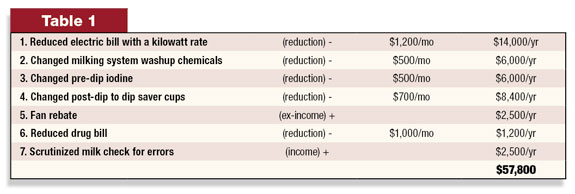In the first two parts (Click here for Part I and click here for Part II) of our discussion, we contemplated a wide variety of topics to keep your dairy healthy. In our third and final part, we will talk about saving money by becoming more energy-efficient, assessing your financial situation and putting a good team together to help you manage the dairy. Let’s first talk about energy savings on your dairy. Why should you care about this? If your dairy needs to “come back to life,” you must seriously look at this category as well as “cow categories.”
Do you know what your kilowatt rate per hour is? Why would you care about this? When we began turning around a dairy five years ago, we considered every line in the budget. We questioned everything.
When we asked about our kilowatt rate, we were shocked to find out what had happened. When the dairy had been set up a couple years previously, no one checked to see that we had a residential rate on the electric bill. Ouch!
When we changed the rate to an industrial rate, we immediately saved $1,200/month. That’s over $14,000/year!
Another item to look at would be other energy rebates. Once again, the previous administration did not check to see that we were eligible for a $2,500 rebate from the local energy co-op for installing large fans in the freestall barn. What a nice check that was to receive.
There were other savings devices every dairy should check into. More energy-efficient lighting should be considered also.
Check both with your local energy co-op and also do a cost/benefit analysis to see how much and how quickly you can make this investment pay off. Don’t forget that a variable speed drive not only brings savings on the energy bill, but also saves wear and tear on the vacuum pump itself.

As I mentioned earlier, I was able to come up with a chart to categorize our savings on the dairy. See Table 1 .
I would here mention points 6 and 7 briefly. At times it seems to me that we have companies who just push drugs as the answer for all that ails your herd. Give them (fresh cows) 20 ml of this particular drug three to four times for every little sniffle all the time.
How about trying fresh feed, delivered in a timely matter, with a nice clean freestall bed and a nice clean water trough and plenty of bunk space per cow? It’s a wonderful alternative to try something more natural.
I understand that occasionally you need the so-called “wonder drugs.” But some of these protocols are put together by people and companies whose only job is to separate you from your hard-earned money.
Part 7 is possibly an odd one to contemplate. Figure out the milk check? Yes! Why? Because milk check formulas can be complicated. Have you ever seen one? It looks something like this: A + B / C x DE – F + G = $. WOW – It’s crazy!
Perhaps you should sit down with your accountant or your milk co-op field man to figure it out. Why care about this? Unfortunately, we had a situation where a former financial adviser didn’t want to be bothered with the actual formula.
The problem was that when we actually talked to the co-op and found out the formula, we discovered the former accountant had never checked each monthly settlement, accepting and depositing without any formal verification. We found several mistakes that amounted to $2,000+ and were reimbursed.
Mistakes can and do happen, but you have to have some kind of check-and-balance system in play to maximize your milk check.
This of course leads to our final topic – a great team. The best running back on a football team can only go so far unless he has blocking for him. On a dairy you will go as far as your milkers, feeders and calf caretakers will take you.
These basic tasks make or break your dairy farm. If you do these well, you will be well on your way to a successful dairy experience. That being said, don’t forget about the professional members of your staff. A good vet service should be one of the cornerstones of your dairy. They most certainly will benefit your dairy.
Just as important is a good nutritionist. Properly formulated rations for the various groups of cows make the difference in growthy heifers and properly conditioned milk cows. We were fortunate to have both of these fine professional people. What a blessing they were!
On the financial side, your team should include an accountant with dairy experience. A bank with an agricultural background should be proactive with your particular situation.
One word of caution with some so-called “advisers.” Please watch those who want a “piece of the action” every time you turn around. Perhaps their motives are not as pure as they make you think. Remember, things may not always be as they seem.
I hope you got a little “food for thought” from this three-part series. Are there not a lot of things to think about when it comes to bringing your dairy back to life? We hope you take away a point or two to get your dairy headed on the right track.
In the future, please e-mail me your “funniest cow or dairy stories.” We will share some and I surely have some to tell. PD

-
Harley Wagenseller
- Dairy Manager
- Blakes Landing Farms
- Email Harley Wagenseller







